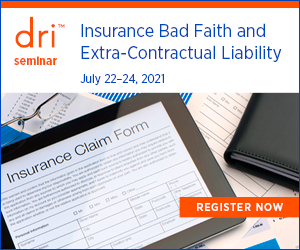Leadership Note
Message from the Chair

By Scott M. Trager
Greetings LHD Committee Members! I am honored to be able to send my first “Message from the Chair” in this new issue of Life, Health and Disability News, and to update you on our Committee’s activities—past, present, and future. Before getting to those, however, I first want to thank Byrne Decker, who so ably led this great committee over the past four years (two years as Chair; two years as Vice Chair). I guess his term as Chair could be summed up as “in like a lamb, out like a lion,” given the unexpected onset of the COVID-19 pandemic. No doubt, Byrne was the perfect leader for this committee and his tireless work kept it moving forward during unprecedented times. I am grateful to Byrne for preparing me to assume the role as Committee Chair—he left with big (running) shoes to fill. I am also thrilled to have Michelle Czapski by my side as Committee Vice Chair as her intellect, thoughtfulness, calm demeanor, and experience as former Chair of the DRI Commercial Litigation Committee, will undoubtedly benefit the LHD Committee for years to come.
While we continue to navigate the COVID-19 pandemic, there is renewed optimism now that spring has finally sprung and vaccines make their way into arms. Just as the days are getting longer, I can definitely see the light at the end of this long, dark tunnel we have been traveling through for over a year now.
As you are well aware, we recently held our signature event, the 2021 DRI Life, Health, Disability, and ERISA Virtual Seminar. Two years in the making, the Seminar again delivered on our promise to serve first-class substantive programming and networking opportunities to you, our members, even in the midst of challenging times. It was well worth the wait, as Program Chair Sarah Delaney, Vice Program Chairs Jamie Moore and Elizabeth Doolin, their planning team, and an outstanding faculty provided an amazing program. I cannot thank them enough. In addition to the stellar line-up of presentations and events, our Committee was proud to present the inaugural Linda Lawson Award to Mark Schmidtke, who has been an exceptional mentor to so many young lawyers over the years. Also, given the Committee’s penchant for giving and charitable causes, we were able to benefit the Pancreatic Cancer Action Network in Linda’s honor. We are already starting to plan the 2022 LHD&E Seminar and welcome Kristina Holmstrom as the Second Vice Program Chair!
In addition to the Seminar, I am proud of the other substantive programming offered (and to be offered) by our Committee this year. In February, as part of DRI’s “Basic Series,” Patrick Begos presented “What Every Litigator Should Know About ERISA.” I am also delighted that DRI has selected two webinars to be presented by the LHD Committee in 2021. The first one is headed your way in May, “LTD Claims Based Upon Increased Risk of Severe Illness Due to COVID-19,” presented by Kristina Pett and Danielle Shure. The other program, “The Data Debacle: Data Breach Class Actions in the Healthcare Industry,” presented by Sarah Cylkowski, is scheduled to be broadcast in early September. In October, we will be teaming up with the Medical Liability and Health Care Law and Government Enforcement and Corporate Compliance Committees at the 2021 DRI Annual Meeting in Boston (fingers crossed) to present “Legal Fallout from Legal Drugs,” featuring our Corporate Vice Chair, John Seybert. John has also coordinated multiple substantive programs on timely topics touching on issues important to in-house counsel.
Of course, being the LHD Committee, we also like to have fun and enjoy each other’s company and maintain our sense of community. Over the past several months, we have lined up many virtual social gatherings, including a holiday party in December, trivia contest in February, and a scavenger hunt in March. We look forward to bringing you more virtual social events throughout the coming year and hope you will participate!
Opportunities abound in the LHD Committee, including through our Committee publications. Each of you are welcome and encouraged to contribute to our excellent platform of publications, including this newsletter, the ERISA Report, The Voice, For The Defense, or In-House Defense Quarterly.
Michelle and I are excited to lead this great committee and we are dedicated to serve you. There’s always room for those who want to get involved and contribute to the Committee’s spirit and strength—the rewards are priceless. Please feel free to contact Michelle or me with any ideas or inquiries. I look forward to seeing you all in person in the not so distant future! In the meantime, please enjoy this issue of the Newsletter. Scott M. Trager, a partner of Funk & Bolton in Baltimore, has a practice covering a broad spectrum of general litigation matters in the state and federal courts of Maryland and the District of Columbia, as well as the Maryland Insurance Administration and Maryland Office of Administrative Hearings. He focuses his practice on the defense of life, health and disability insurance claims (ERISA and non-ERISA), as well as administrative claims before insurance regulators. He also has extensive experience with policy rescissions and interpleaders.
Scott M. Trager, a partner of Funk & Bolton in Baltimore, has a practice covering a broad spectrum of general litigation matters in the state and federal courts of Maryland and the District of Columbia, as well as the Maryland Insurance Administration and Maryland Office of Administrative Hearings. He focuses his practice on the defense of life, health and disability insurance claims (ERISA and non-ERISA), as well as administrative claims before insurance regulators. He also has extensive experience with policy rescissions and interpleaders.

It’s Membership May! Throughout the month of May, DRI is asking you to "Just Get One" peer to join DRI. For every member you recruit in the month of May, you will receive $100 advocate certificate and one entry into a random drawing for a variety of prizes. We made it easy for you - visit our online tool kit for talking points, email copy, social media content, the membership application, etc. for you to use! If you need any other tools, please feel free to contact membership@dri.org.












